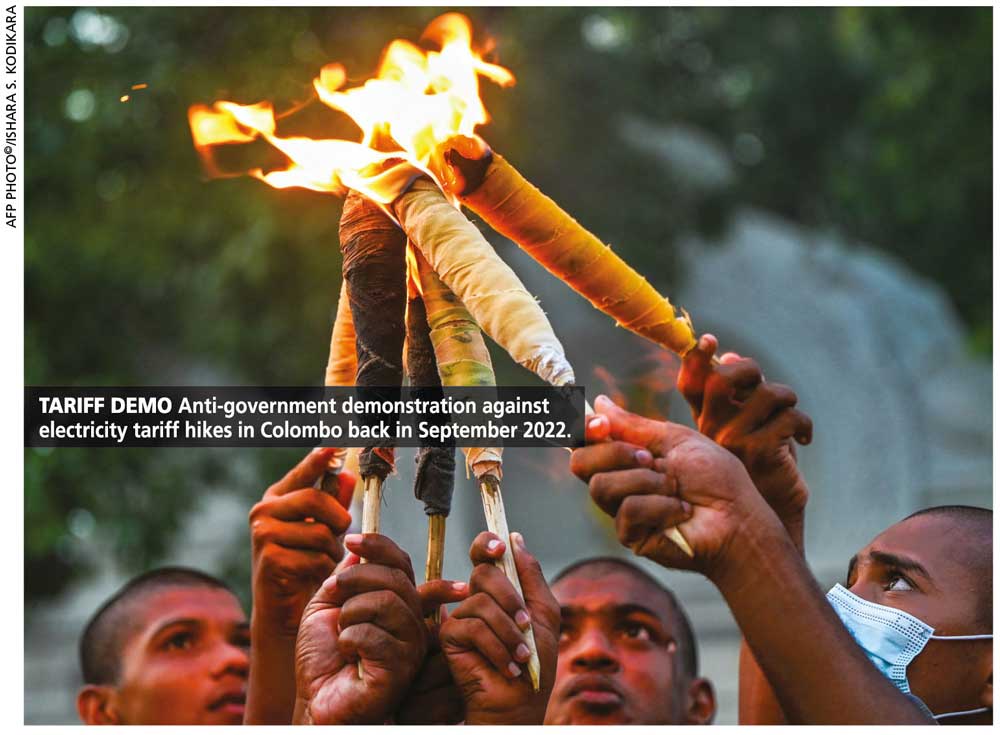POWER PIVOT: FUTURE CHARGED
Tamara Rebeira previews the power struggles and energy stability in 2024

Year 2024 is bound to be remembered for a series of events with the power sector – particularly related to tariff hikes – standing out like a sore thumb. Despite strides towards improvement, the country found itself thrust into a temporary state of PTSD during a recent hours long power outage.
The culprit? A supposed lightning strike at a power plant – thankfully.
The irony is hard to ignore, especially considering the efforts made to upgrade our energy infrastructure. However, Sri Lanka’s recent power outage unveils a stark reality, indicating a gap between aspirations and implementation.
We heavily rely on hydropower with coal and oil filling the gaps. And during the dry season, the country is forced to turn to thermal power for a large share of its electricity needs.
Currently, the focus is on regional energy integration with plans for grid connectivity between Sri Lanka and India to be realised by 2030. While Sri Lanka is presently dependent on energy imports, moves are underway to alleviate the ensuing economic burden by aiming to generate 70 percent of electricity through renewable sources.
Moreover in November, officials from the World Bank engaged in discussions regarding the proposed power interconnectivity with neighbouring India.
President Ranil Wickremesinghe has also emphasised the government’s commitment to prioritising regional energy integration, focussing particularly on the Mannar region.
He expressed optimism, highlighting the vast potential for a green economy and green energy in Mannar, especially given the abundant solar power resources available in the region. But whether these plans will materialise or how long it’ll take is a story for another day – after all, discussions about linking the power grids of India and Sri Lanka have been ongoing since the 1970s!
Additionally, there’s growing concern about a select group of officials, dubbed ‘the mafia,’ who are accused of hindering progress by their interference. Their primary worry is apparently the impact of rapidly expanding wind, solar and other projects, which could undermine their influence.
In 2022, we faced a challenging period when daily power cuts disrupted normal life for months. The reasons for this unsettling period were diverse; they included low water levels for hydroelectricity generation, and difficulties in importing sufficient fuel and coal, worsened by a shrinking economy.
Although power cuts were brought to a halt last year, there’s a growing sense of disdain among the public regarding the government’s strategy to boost revenue by increasing electricity tariffs. The concerns gripping the public revolve around the spiralling burden of paying for electricity.
What’s more, the struggle between the Public Utilities Commission of Sri Lanka (PUCSL), which holds the key to approving tariff adjustments, adds complexity to an already dire situation.
Proposals for tariff revisions must undergo scrutiny and gain approval from the PUCSL; and therefore, it’ll be tasked with balancing the interests of the public and weighing the need for any further tariff hikes.
Simultaneously, Minister of Power and Energy Kanchana Wijesekera has asserted that the proposed revisions are intended to bring relief to the people. So with hydroelectricity operating at its maximum capacity, there’s optimism for a downward trend in tariffs. In October, the hike in electricity charges was attributed to high costs associated with production using fossil fuels.
The public will also breathe a sigh of relief, as Wijesekera has assured that the January revision will not be affected by value added tax (VAT). He clarified that the power sector – including materials used for power generation like naphtha and coal – is exempt from tax.
And the ongoing dialogue suggests a commitment to transparency and a desire to incorporate diverse perspectives into the decision-making process.
However, solving the power crisis is not merely a technical puzzle. The narrative of 2024 is still unfolding and only time will reveal how this chapter shapes the country’s future energy landscape.





